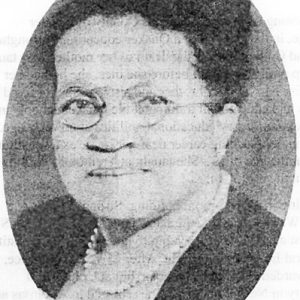calsfoundation@cals.org
Anna Strong (1884–1966)
Anna Strong was a noted African-American teacher and school principal in Marianna (Lee County). She also served one term as president of the Arkansas Teachers Association (ATA). Strong labored to provide quality education to the African-American citizens of Lee County and was widely recognized for her efforts.
Anna Mae Paschal was born in rural Phillips County in 1884 to Chandler and Lucy Paschal. Her father, active in the Religious Society of Friends (generally known as Quakers), was listed in the 1880 census as a miller. Anna Paschal was the oldest of four children and helped her parents to raise her sister and brothers. She began her educational and religious training with the Quakers at the highly regarded Southland School at Lexa (Phillips County). At the age of thirteen, she began her teaching career near her home as a substitute teacher and, one year later, was teaching in Trenton (Phillips County).
She married William A. Strong, a building contractor from Marianna, and began teaching in a three-room building there. The couple had two children. The date of their marriage is not known, but according to census records she was widowed by 1920.
Anna Strong was granted a one-year scholarship by the General Educational Board to attend Tuskegee Institute in Tuskegee, Alabama. Though she did not earn a degree, she was later granted several honorary degrees for her accomplishments. Strong served as the principal of Robert R. Moton High School in Marianna from 1926 to 1957.
Strong was elected president of the Arkansas Teachers Association in 1929 and served until 1930. In her initial address to the organization, she encouraged the teachers to continue their own education and to pay attention to the health of their students as well as to their education. In 1932, the organizational and leadership skills of Strong were recognized by the Arkansas Department of Education (ADE), and she was appointed assistant supervisor of education for rural black schools in the state.
In this position, while still serving as principal of the Robert R. Moton High School, she established an educational program for rural schools known as the Key Schools Program (KSP), a program designed to develop rural life through a coordinated effort of the home, school, and church. Teachers in the KSP attended a ten-week summer workshop at Arkansas AM&N College in Pine Bluff (Jefferson County), now the University of Arkansas at Pine Bluff (UAPB), where they were given scrip on scholarships paid for by the General Education Board. The KSP began with twenty schools in 1934 and grew to more than 100 schools by 1940; the program was recognized by the ADE as one of the most successful and innovative educational programs in the state.
Lee County, like most counties in the Delta, was dominated by elite white planters who were not particularly concerned with the education of the children of their cheap labor forces. Strong, however, was determined to improve the quality of life for her students and their families. When Strong became principal of Moton High School, the facility was a three-room training school located in the middle of a cotton field. Under her leadership, the school grew into a nine-room structure with thirteen teachers. Before her tenure ended, the school boasted a two-story brick building with fourteen classrooms, a 625-seat auditorium, and a separate vocational agricultural building.
While serving as principal of Moton High School and directing the Key School Programs, she participated in state, regional, and national professional organizations in which her communication and leadership skills were recognized. In addition to serving as president of the ATA, she represented Arkansas in 1934 in Washington DC at the first National Conference on Fundamental Problems in the Education of Negroes, organized by Secretary of the Interior Harold Ickes. Strong also served as president of the American Teachers Association, which she helped to establish. At the 1942 meeting of the American Teachers Association, she shared the stage with First Lady Eleanor Roosevelt, one of its chief supporters.
Anna M. P. Strong Gymnasium was built in 1950, Strong Elementary School was built in 1957, and Anna Strong High School was built in 1962. After her retirement as a principal in May 1957, the Marianna School Board named her as supervisor of the new school cafeteria.
Strong died on March 14, 1966, in Marianna. She is buried in the family plot at Memorial Gardens in Phillips County. Among her many honors were an honorary doctorate from Arkansas AM&N College in 1954 and being named “Woman of the Year” by Zeta Phi Beta Sorority 1955.
For additional information:
Apple, Nancy, and Suzy Keasler, eds. History of Lee County, Arkansas. Dallas: Curtis Media Group, 1987.
Patterson, Thomas E. History of the Arkansas Teachers Association. Washington DC: National Education Association, 1981.
Smith, C. Calvin, and Linda Walls Joshua, eds. Educating the Masses: The Unfolding History of Black School Administrators in Arkansas, 1900–2000. Fayetteville: University of Arkansas Press, 2003.
Bill Shrum
Stuttgart, Arkansas
Staff of the CALS Encyclopedia of Arkansas
 Anna Strong
Anna Strong 




Mrs. Anna Strong was a friend of Dr. Mary McLeod Bethune and visited her at Bethune-Cookman College in Florida when I was a student at R. R. Moton High School in Marianna, Arkansas.